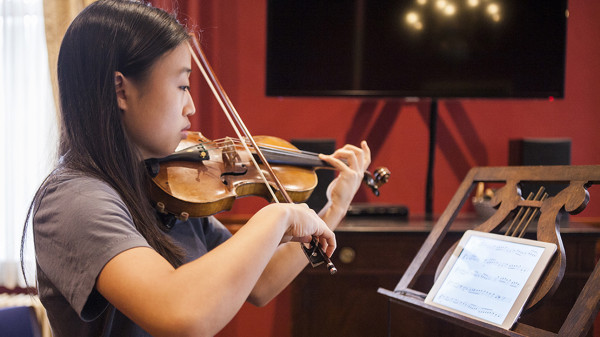
Harvard Innovation Labs Companies – i-lab – Cadenza – 10/43
Harvard Innovation Labs Companies – i-lab – Cadenza – 10/43
Cadenza
Cadenza app is an orchestra on your phone
When violin student Yoo Jin Ahn was practicing to perform as a soloist at Carnegie Hall earlier this month, she had a secret weapon at her disposal: an iOS app called Cadenza. The app, which was developed by former i-lab startup Sonation, plays the orchestral part that accompanies a piece of music while a musician performs the solo melody.
When violin student Yoo Jin Ahn was practicing to perform as a soloist at Carnegie Hall earlier this month, she had a secret weapon at her disposal: an iOS app called Cadenza.
Cadenza, which was developed by a Boston-based startup called Sonation, plays the orchestral part that accompanies a piece of music — in Ahn’s case an intermezzo by French composer Jules Massenet — while a musician performs the solo melody. As the musician plays, Cadenza listens, and adjusts the speed of the orchestra to keep pace. The result, according to Ahn, is a freedom to experiment with the tempo and phrasing that she’s never before experienced during the 12 years she’s studied the violin, almost like rehearsing with live accompaniment.
“The composer makes the music thinking about how the music will sound with an orchestra,” said Ahn, a senior at Brookline High School who plans to study performance in college. “So when you practice on your own, you’re only getting half the story.”
Before he started Sonation, cofounder Paul Henry Smith operated a company called the Fauxharmonic Orchestra, where he used digital instruments to produce orchestral recordings for composers or film and video game studios. At the Fauxharmonic Orchestra, he often wished that there existed a tool that could detect a soloist’s tempo changes and change the speed of the accompaniment in real time. Software like that, he imagined, would give a musician unprecedented freedom to experiment and rehearse the kinds of expressive changes she might employ if she were performing with a live ensemble.
From time to time, Smith would search the Internet to see if anyone had made progress toward that goal. Eventually, in 2012, he found a reference to a researcher at Indiana University named Christopher Raphael who had created precisely the type of software Smith had been imagining.
To develop the software, Raphael had overcome significant mathematical and computer science hurdles. He had been working on a solution, in fact, since the early 1990s.

